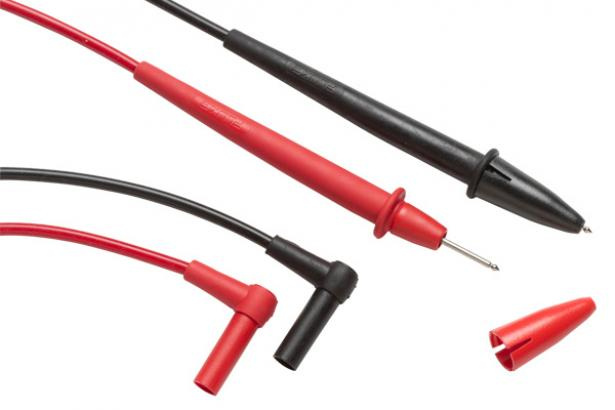Part 3
Multimeter basics
 Warning: Voltages above 30V are dangerous.
Warning: Voltages above 30V are dangerous.
Introduction
A good multimeter does not have to cost a fortune. If you need one twice a year, don’t shell out $200.
I would recommend to buy one with detachable leads so you can hook up the right probe for the right job.
Most cheap multimeters have 3 settings:
- Voltage
- Current
- Resistance (included Continuity)
Other functions you may find:
- Diode Test
- Capacitance (hit & miss in my experience)
- Inductance (Multimeter ≠ Inductance meter, very different devices)
- Temperature (using a thermocouple, often with an adapter)
- Frequency Counter (hit & miss in my experience)
- Transistor tester (what for? Don’t you have a datasheet?)
- Max/Min Function
- Hold (Flukes Auto-Hold is
 )
)
- Backlight
- Range Adjust
Measureing
Range selection
When your meter does not do this automatically, you select the range that includes the highest value you expect.
Note that when measureing current, the inrush current may be a lot higher than current while the load is running.
To throw all beginners into the deep end, welcome to the bastard meter from hell:
90V is the outer one.
20V is the center scale.
For 10A, you have to take the same scale as 20V, but divide by 2. And the 1A scale is the inner one, divided by 10. Don’t laugh, I have seen this in the wild!
The only good feature of this example piece is the fact it requires you to plug the probes from Black&Blue for volts to Green&Black for Amps.
There are meters that shutter the incorrect ports so you don’t blow up fuses (Gossen Metrawatt does this on a lot of their meters).
Do yourself a favour, buy a good meter.
Probing
Do get good results, you need good contact. The manual probes will often be “good enough” for resistances or finding if there is voltage presend. For everything beyond that, you want alligator clamps, screw terminals, 4mm hookups, etc.
That way your fingers (and body) don’t skew the results or put your heart and lungs into the line of fire.
 When Probing arround >30V, use shielded test leads like the ones below. Only use 1 hand to hold the probes, the other hand holds the meter.
When Probing arround >30V, use shielded test leads like the ones below. Only use 1 hand to hold the probes, the other hand holds the meter.
↑ Honestly though, use clamps/plugs to hook up and don’t even touch whatever you measure.
Correct Meter Positioning
Current (A) - Your meter will be in series with the load. In this example, a light bulb.

This is also how you measure resistance, capacitance, etc. Just without the battey in circuit.
Voltage (V) - Your meter will be in parallel with the load.

 Urgent Advice: After EVERY use, plug the leads back to measure volts.
Urgent Advice: After EVERY use, plug the leads back to measure volts.
That way you will not blow up your meter or the fuses inside it by accident.
Purchase advice
You want a True-RMS (= TRMS) meter, simply because these types of meter can measure AC.
The measurement leads should have guards so your fingers don’t slip into the danger zone.
Fluke TL 75 for example:

Analogue vs Digital
I find analog meters to be way too much hassle. The neelde is never readable, accuracy is at the mercy of correctly positioning the meter and there are multiple scales of which you have to read the right one.
Buy a digital meter and you are set, even when holding the meter at wierd angles.
Autorange vs Manual
Do you want to think about the highest value you could see?
Do you want to step through the ranges until you get a usefull measurement?
Are you mad?
Answered any of the above questions with yes, then get a Manual one. All the normal people, save yourself the hassle and get an auto-ranging one.
Brands that won’t blow up in your face:
Misc Advice
Help! My meter does not measure amps!
→ Have you checked you got the test leads plugged in correctly?
→ Correct range selected?
→ Still nope? You blew a fuse. Time to open the battery cover (or the entire meter) and replace it
Fuses
You want ceramic fuses in all your devices, especially the multimeter you have in your hand.
The good ones are filled with a fine sand that will take up the metal vapour under extreme fault conditions interrupting the current flow. Glas fuses may cover their insides in metal, which will then conduct making them explode.
Video showcasing fuses under fault conditions

 Warning: Voltages above 30V are dangerous.
Warning: Voltages above 30V are dangerous. )
)



 Urgent Advice: After EVERY use, plug the leads back to measure volts.
Urgent Advice: After EVERY use, plug the leads back to measure volts.















